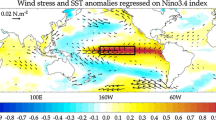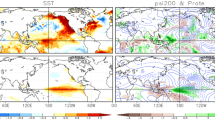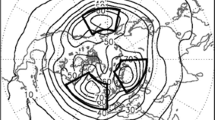Abstract
In this paper we seek to identify inter-annual sea surface temperature anomalies (SSTA) patterns outside the tropical Pacific that may influence El Niño/Southern Oscillation (ENSO) through atmospheric teleconnections. We assume that a linear ENSO hindcast based on tropical Pacific warm water volume and Niño3.4 SSTA indices captures tropical Pacific intrinsic predictability inherent to recharge oscillator dynamics. This simple hindcast model displays statistically significant skill at the 95 % confidence level at leads of up to seven seasons ahead of the ENSO peak. Our results reveal that ENSO-independent equatorial wind stress anomalies only significantly improve the skill of that linear hindcast at the 95 % level in boreal spring and summer before the ENSO peak and in boreal fall, five seasons ahead of the ENSO peak. At those seasons, the robust large-scale SST patterns that provide a statistically significant enhancement of ENSO predictability are related to the Atlantic meridional mode and south Pacific subtropical dipole mode in spring, the Indian Ocean Dipole and the south Atlantic subtropical dipole mode in fall. While the first two regions display significant simultaneous correlations with western equatorial Pacific wind stress in three reanalyses (ERA-I, NCEP and NCEP2), the Indian Ocean Dipole and south Atlantic subtropical dipole mode correlation with Pacific winds is less robust amongst re-analyses. We discuss our results in view of other studies that suggest a remote influence of various regions on ENSO. Although modest, the sensitivity of our results to the dataset and to details of the analysis method illustrates that finding regions that influence ENSO from the statistical analysis of observations is a difficult task.







Similar content being viewed by others
Notes
Before spring, SST 19-22 months and 27-28 months ahead of the ENSO peak is a weakly significant predictor of the ENSO peak (Fig 1a), probably because of the broad ENSO spectral peak around ~4 years.
References
Alory G (2002) Inter-annual sea level changes and associated mass transports in the tropical Pacific from TOPEX/Poseidon data and linear model results (1964–1999). J Geophys Res 107:3153
Annamalai H, ** El Niño*. J Clim 18:302–319
Barnston AG, He Yuxiang, Glantz MH (1999) Predictive skill of statistical and dynamical climate models in sst forecasts during the 1997–1998 El Niño episode and the 1998 La Niña onset. Bull Am Meteor Soc 80:217–243
Barnston AG, Tippett MK, L’Heureux ML, Li S, DeWitt DG (2012) Skill of real-time seasonal ENSO model predictions during 2002–2011: is our capability increasing? Bull Am Meteorol Soc 93:631–651
Bjerknes J (1969) Atmospheric teleconnections from the equatorial pacific 1. Mon Weather Rev 97:163–172
Bosc C, Delcroix T (2008) Observed equatorial Rossby waves and ENSO-related warm water volume changes in the equatorial Pacific Ocean. J Geophys Res 113:C06003
Boschat G, Terray P, Masson S (2013) Extratropical forcing of ENSO. Geophys Res Lett 40:1605–1611. doi:10.1002/grl.50229
Boulanger J-P, Menkes C, Lengaigne M (2004) Role of high- and low-frequency winds and wave reflection in the onset, growth and termination of the 1997–1998 El Niño. Clim Dyn 22:267–280
Bretherton CS, Widmann M, Dymnikov VP, Wallace JM, Bladé I (1999) The effective number of spatial degrees of freedom of a time-varying field. J Clim 12:1990–2009
Chiang JCH, Vimont DJ (2004) Analogous pacific and Atlantic meridional modes of tropical atmosphere–ocean variability*. J Clim 17:4143–4158
Clarke AJ, Van Gorder S (2003) Improving El Niño prediction using a space-time integration of Indo-Pacific winds and equatorial Pacific upper ocean heat content. Geophys Res Lett 30:1399
Clarke AJ, Van Gorder S (2001) ENSO prediction using an ENSO trigger and a proxy for Western equatorial pacific warm pool movement. Geophys Res Lett 28:579–582
Cleveland RB, Cleveland WS, McRae JE, Terpenning I (1990) A seasonal-trend decomposition procedure based on loess (with discussion). J Off Stat 6:3–73
Compo GP, Sardeshmukh PD (2010) Removing ENSO-related variations from the climate record. J Clim 23:1957–1978
Dee DP, Uppala SM, Simmons AJ et al (2011) The ERA-Interim reanalysis: configuration and performance of the data assimilation system. Q J R Meteorol Soc 137:553–597
Deser C, Wallace JM (2003) Understanding the persistence of sea surface temperature anomalies in midlatitudes. J Clim 16:57–72
Deser C, Alexander MA, **e S-P, Phillips AS (2010) Sea surface temperature variability: patterns and mechanisms. Annu Rev Marine Sci 2:115–143
Gill AE (1980) Some simple solutions for heat-induced tropical circulation. Q J R Meteorol Soc 106:447–462
Gleckler PJ, Santer BD, Domingues DM, Pierce DW, Barnett TP, Church JA, Taylor KE, AchutaRao KM, Boyer T, Ishii M, Caldwell PM (2012) Human-induced global ocean warming on multidecadal timescales. Nat Clim Chang. Published online, doi:10.1038/nclimate1553
Ham Y-G, Kug J-S, Park J-Y, ** F–F (2013) Sea surface temperature in the north tropical Atlantic as a trigger for El Niño/Southern oscillation events. Nat Geosci 6:112–116. doi:10.1038/ngeo1686
Harrison DE, Larkin NK (1998) El Niño-Southern Oscillation Sea surface temperature and wind anomalies, 1946–1993. Rev Geophys 36:353
Hurrell JW, Trenberth KE (1999) Global sea surface temperature analyses: multiple problems and their implications for climate analysis, modeling, and reanalysis. Bull Am Meteor Soc 80:2661–2678
Izumo T, Vialard J, Lengaigne M, de Boyer Montegut C, Behera SK, Luo JJ, Cravatte S, Masson S, Yamagata T (2010) Influence of the state of the Indian Ocean dipole on the following year’s El Niño. Nat Geosci 3:168–172. doi:10.1038/ngeo760
** F-F (1996) Tropical ocean-atmosphere interaction, the pacific cold tongue, and the El Niño-southern oscillation. Science 274:76–78
** F-F (1997a) An equatorial ocean recharge paradigm for ENSO. Part I: conceptual model. J Atmos Sci 54:811–829
** F-F (1997b) An equatorial ocean recharge paradigm for ENSO 2. A stripped-down coupled model. J Atmos Sci 54:830–847
Kalnay E, Kanamitsu M, Kistler R, Collins W, Deaven D, Gandin L, Iredell M, Saha S, White G, Woollen J, Zhu Y, Chelliah M, Ebisuzaki W, Higgins W, Janowiak J, Mo KC, Ropelewski C, Wang J, Leetmaa A, Reynolds R, Jenne R, Joseph D (1996) The NCEP/NCAR 40-year reanalysis project. Bull Am Meteorol Soc 77:437–471
Kanamitsu M, Ebisuzaki W, Woollen J et al (2002) NCEP–DOE AMIP-II reanalysis (R-2). Bull Am Meteorol Soc 83:1631–1643
Kessler WS (2002) Is ENSO a cycle or a series of events? Geophys Res Lett 29:2125
Klein SA, Soden BJ, Lau N-C (1999) Remote sea surface temperature variations during ENSO: evidence for a tropical atmospheric bridge. J Clim 12:917–932
Kug J-S, Kang I-S (2006) Interactive feedback between the Indian Ocean and ENSO. J Clim 19:1784–1801
Latif M, Anderson D, Barnett T et al (1998) A review of the predictability and prediction of ENSO. J Geophys Res 103:14375
Lengaigne M, Guilyardi E, Boulanger J-P et al (2004) Triggering of El Niño by westerly wind events in a coupled general circulation model. Clim Dyn 23:601–620
Lengaigne M, Boulanger J-P, Menkes C, Spencer H (2006) Influence of the seasonal cycle on the termination of El Niño events in a coupled general circulation model. J Clim 19:1850–1868
Lengaigne M, Hausmann U, Madec G, Menkes C, Vialard J, Molines JM (2011) Mechanisms controlling warm water volume inter-annual variations in the equatorial Pacific: diabatic versus adiabatic processes. Clim Dyn 38:1031–1046
Lloyd J, Guilyardi E, Weller H (2010) The role of atmosphere feedbacks during ENSO in the CMIP3 models. Part II: using AMIP runs to understand the heat flux feedback mechanisms. Clim Dyn 37:1271–1292
McCreary J (1976) Eastern tropical ocean response to changing wind systems: with application to El Niño. J Phys Oceanogr 6:632–645
McPhaden MJ, Zebiak SE, Glantz MH (2006a) ENSO as an integrating concept in earth science. Science (NY) 314:1740–1745
McPhaden MJ, Zhang X, Hendon HH, Wheeler MC (2006b) Large scale dynamics and MJO forcing of ENSO variability. Geophys Res Lett 33:L16702
Meehl GA (1993) A coupled air-sea biennial mechanism in the tropical Indian and Pacific regions: role of the ocean. J Clim 6:31–41
Meinen CS, McPhaden MJ (2000) Observations of warm water volume changes in the equatorial pacific and their relationship to El Niño and La Niña. J Clim 13:3551–3559
Newman M, Compo G, Alexander MA (2003) ENSO-forced variability of the Pacific Decadal Oscillation. J Clim 16:3853–3857
Nobre P, Shukla J (1996) Variations of sea surface temperature, wind stress, and rainfall over the tropical Atlantic and South America. J Clim 9:2464–2479
Ohba M, Ueda H (2007) An impact of SST anomalies in the Indian Ocean in acceleration of the El Niño to La Niña transition. J Meteor Soc Jpn 85:335–348
Praveen Kumar B, Vialard J, Lengaigne M, Murty VSN, McPhaden MJ (2011) TropFlux: air-sea fluxes for the global tropical oceans—description and evaluation. Clim Dyn 38:1521–1543
Praveen Kumar B, Vialard J, Lengaigne M et al (2012) TropFlux wind stresses over the tropical oceans: evaluation and comparison with other products. Clim Dyn 40:2049–2071
Rasmusson EM, Carpenter TH (1982) Variations in tropical sea surface temperature and surface wind fields associated with the southern oscillation/El Niño. Mon Weather Rev 110:354–384
Rodríguez-Fonseca B, Polo I, García-Serrano J et al (2009) Are Atlantic Niños enhancing Pacific ENSO events in recent decades? Geophys Res Lett 36:L20705
Saji NH, Goswami BN, Viayachandran PN, Yamagata T (1999) A dipole mode in the tropical Indian ocean. Nature 401:360–363
Smith NR (1995) An improved system for tropical ocean subsurface temperature analyses. J Atmos Oceanic Technol 12:850–870
Terray P (2010) Southern hemisphere extra-tropical forcing: a new paradigm for El Niño-Southern oscillation. Clim Dyn 36:2171–2199
Terray P, Dominiak S (2005) Indian Ocean sea surface temperature and El Niño–Southern Oscillation: a new perspective. J Clim 18:1351–1368
Trenberth KE (2002) Evolution of El Niño–Southern Oscillation and global atmospheric surface temperatures. J Geophys Res 107:4065
Trenberth KE, Branstator GW, Karoly D, Kumar A, Lau N-C, Ropelewski C (1998) Progress during TOGA in understanding and modeling global teleconnections associated with tropical sea surface temperatures. J Geophys Res 103(C7):14291–14324. doi:10.1029/97JC01444
Uppala SM, KÅllberg PW, Simmons AJ et al (2005) The ERA-40 re-analysis. Q J R Meteorol Soc 131:2961–3012
Vecchi GA, Wittenberg AT, Rosati A (2006) Reassessing the role of stochastic forcing in the 1997–1998 El Niño. Geophys Res Lett 33:L01706. doi:10.1029/2005GL024738
Vimont DJ, Battisti DS, Hirst AC (2001) Footprinting: a seasonal connection between the tropics and mid-latitudes. Geophys Res Lett 28:3923–3926
Vimont DJ, Wallace JM, Battisti DS (2003) The seasonal footprinting mechanism in the Pacific: implications for ENSO*. J Clim 16:2668–2675
Wang F (2010) Subtropical dipole mode in the Southern Hemisphere: a global view. Geophys Res Lett 37:L10702. doi:10.1029/2010GL042750
Webster PJ, Yang S (1992) Monsoon and ENSO: selectively interactive systems. Q J R Meteorol Soc 118:877–926
**e S-P, Hu K, Hafner J et al (2009) Indian Ocean capacitor effect on Indo–Western Pacific climate during the summer following El Niño. J Clim 22:730–747
Yamagata T, Behera SK, Luo J-J, Masson S, Jury M, and Rao SA (2004) Coupled ocean-atmosphere variability in the tropical Indian Ocean. In: Wang C, **e S-P, and Carton JA (eds) Earth climate: the ocean-atmosphere interaction. Geophys Monogr Ser, 147. AGU, Washington, DC, pp 189–212
Zebiak SE (1993) Air–sea interaction in the equatorial Atlantic region. J Clim 6:1567–1586
Zhang C (2005) Madden-Julian Oscillation. Rev Geophys 43:RG2003. doi:10.1029/2004RG000158
Zhang H, Clement A, Di Nezio P (2013) The South pacific meridional mode: a mechanism for ENSO-like variability. J Clim (in revision)
Acknowledgments
Jérôme Vialard, Takeshi Izumo and Matthieu Lengaigne are funded by Institut de Recherche pour le Développement (IRD). Hugo Dayan is funded by a PhD grant of Minsitère de l’Enseignement Supérieur et de la Recherche and by the Institut National des Sciences de l’Univers (INSU) LEFE program. We thank Pascal Terray for numerous discussions on this work, and precious help with the use of the StatPack package.
Author information
Authors and Affiliations
Corresponding author
Rights and permissions
About this article
Cite this article
Dayan, H., Vialard, J., Izumo, T. et al. Does sea surface temperature outside the tropical Pacific contribute to enhanced ENSO predictability?. Clim Dyn 43, 1311–1325 (2014). https://doi.org/10.1007/s00382-013-1946-y
Received:
Accepted:
Published:
Issue Date:
DOI: https://doi.org/10.1007/s00382-013-1946-y




